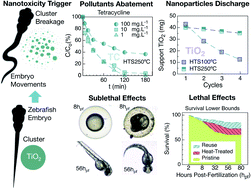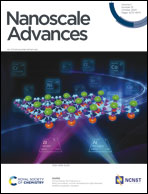Are TiO2 nanoparticles safe for photocatalysis in aqueous media?†
Abstract
Although environmental and toxicity concerns are inherently linked, catalysis using photoactive nanoparticles and their hazardous potential are usually addressed independently. A toxicological assessment under the application framework is particularly important, given the pristine nanoparticles tend to change characteristics during several processes used to incorporate them into products. Herein, an efficient TiO2-functionalized macroporous structure was developed using widely adopted immobilization procedures. The relationships between photocatalysis, catalyst release and associated potential environmental hazards were assessed using zebrafish embryonic development as a proxy. Immobilized nanoparticles demonstrated the safest approach to the environment, as the process eliminates remnant additives while preventing the release of nanoparticles. However, as acute sublethal effects were recorded in zebrafish embryos at different stages of development, a completely safe release of TiO2 nanoparticles into the aquatic environment cannot be advocated.



 Please wait while we load your content...
Please wait while we load your content...